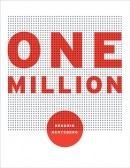(Most) Thursdays (sometimes Fridays) bring a post about a paperback book.
 Hendrik Hertzberg’s One Million consists of 200 pages, 5,000 dots per page. That’s one million total dots in the book, with two, three, or four dots (and their corresponding numbers) “called out” on each page with an explanatory note. For instance: “499,999: Christian hymns in existence.” The project seems meant, if this isn’t paradoxical, as a playful way to give you a headache.
Hendrik Hertzberg’s One Million consists of 200 pages, 5,000 dots per page. That’s one million total dots in the book, with two, three, or four dots (and their corresponding numbers) “called out” on each page with an explanatory note. For instance: “499,999: Christian hymns in existence.” The project seems meant, if this isn’t paradoxical, as a playful way to give you a headache.
A version of the book was originally published in 1970, but this is a thoroughly revised edition. (The only statistics that I assume strongly reflect the first version are the dozens that remain about Vietnam.) Hertzberg’s sly selections and juxtapositions are all we have to go on for a larger message. There are a lot of statistics about real estate and cars and employment (“22,000: newspaper jobs lost in 2008”), which seem appropriate given the financial story of the past couple of years. Less obviously explained is the abundance of facts about Texas; perhaps the lingering influence of the Bush years on Hertzberg, who writes about politics for The New Yorker.
As the pages gather on your left side, it does become easier to feel the impact of certain numbers, no matter how trivial: “696,853: Units of Wii Fit, the video game, sold in November 2008.” That’s just about one Wii Fit (in one month) for every hour that has passed since Mickey Mouse debuted in 1928.
See, this is the effect of One Million. Be prepared to think differently for a few hours after browsing its pages.
The numbers often seem insanely large: “843,836: books by Stephenie Meyer sold every two weeks in 2008.” (Italics mine.) That means that Meyer must have enough money to start a human trafficking operation on Jupiter. Be afraid.
More rarely, surprisingly small: Not even a million hours have passed since Hawaii became a U.S. territory in 1900.
The statistics Hertzberg has chosen are naturally very limited, of course, the number of them seeming particularly tiny after reading of solar-system-scaled quantities in the book’s mind-bending introduction. With so many dots unclaimed, it’s tempting to fill in some of the blank spaces with findings and interests of your own. In fact, One Million might be the ideal book for readers who love to scribble in the margins.

